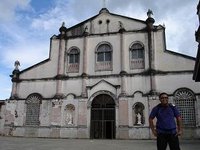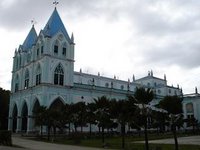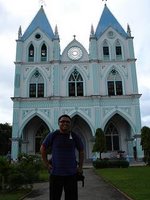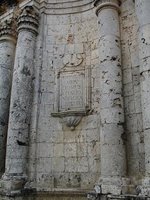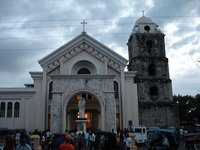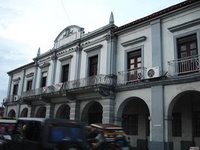 |
| Loboc Church (San Pedro Apostol) was built in 1734. If was founded as a Jesuit mission in 1596. |
Bohol is a province of rich heritage. It has the largest number of well-preserved heritage churches in the country if I may say. Yes, the history of the churches in Bohol has been respected by most of the local clergy, especially in the Diocese of Tagbilaran (the other Bohol diocese is the Diocese of Tubigon). And visits to these exquisite churches are enriching experiences, as they give us a glimpse of our colorful folk art, Philippine Baroque as many call it.
Here are three routes with interesting churches. The first two, 1a and 1b can be combined into one grand route. It can be accomplished in a day if you rent a car or van (but you have to start early). You may also opt to enjoy the beaches in Anda and stay overnight or start from Anda and make your way back:
Route 1a: Tagbilaran, Dauis, Panglao, Baclayon, Alburquerque, Loay, Loboc (enjoy the Loboc River Cruise or proceed to Chocolate Hills from here)
Route 1b: (from Loay) Lila, Dimiao, Valencia, Garcia Hernandez, Jagna, Duero, Anda
Route 2: Tagbilaran, Cortes, Maribijoc, Loon, Calape, Tubigon (proceed to Talibon if you have time)
 |
| Tagbilaran Cathedral (St. Joseph the Worker) |
 |
| Dauis Church (Assumption of Our Lady) is a National Cultural Treasure and National Historical Landmark. The present church dates back to 1863. |
 |
| The interior of the Dauis Church features the illusion of a Renaissance artesonado or coffered ceiling. The paintings inside the church are attributed to Ray Francia and Canuto Avila (and his children). Notice the small well on the floor in front of the main altar |
 |
| The Dauis Watchtower is a National Cultural Treasure. It was built in 1774 as a lookout for Moro pirates |
 |
| Panglao Church (San Agustin) is a National Cultural Treasure. The present church was built between 1894 to 1897. Notice the ruins of the old church nearby |
 |
| Ceiling murals inside the Panglao Church |
 |
| The Panglao Watchtower built close to the sea in 1851 is also a National Cultural Treasure |
 |
| Baclayon Church (La Purisima Concepcion de la Virgen Maria) is a National Cultural Treasure. The present church dates back to 1727. The interior of the church, particularly the retablo mayor, is one of the best examples of Philippine Baroque. |
 |
| Alburquerque Church (Santa Monica) dates back to 1885 |
 |
| Loay Church (La Santisima Trinidad) is a National Historical Landmark. The church, built on top of a hill, dates back to 1822. Other historic structures in the church complex include the belltower, convento and two schoolhouses. Across the plaza is the old tribunal or municipal hall. |
 |
| The ceiling murals of Loay Church are attributed to Ray Francia. The sanctuary is unique in the country for its lace-like design. |
 |
| The ceiling murals of the Loboc Church are attributed to Canuto Avila, Ricardo Avila and Rey Francia. |
 |
| Dimiao Church (San Nicolas de Tolentino) is a National Cultural Treasure. The present church was built from 1800 to 1815. Beside the church is an old walled cemetery which the locals call ermita |
 |
| The interior of Dimiao Church |
 |
| While there is nothing remarkable about the facade of the Valencia Church (Sto. Nino), the interior features ornate wooden floor patterns |
 |
| The facade of the Jagna Church (San Miguel Arcangel) is heavily renovated. But the interior is fortunately intact. The ceiling features paintings of Rey Francia |
 |
| Duero Church (Immaculate Conception) is considered one of the gems of Philippine architecture in wood. Yes, the church is made of wood and dates back to 1874 |
 |
| Anda Church (Sto. Nino) may look unimpressive outside, but is richly decorated inside. Splendid ceiling murals by Rey Francia adorn the ceiling |
 |
| The Anda Church ceiling murals were painted on tin sheets |
 |
| Cortes Church (Santisimo Nombre de Jesus) dates back to 1892. The painted ceilings inside are by Rey Francia. |
 |
| Maribojoc Church (La Santa Cruz) is a National Cultural Treasure. The present church was built in 1852 |
 |
| Inside Maribojoc Church are five magnificently carved Gothic retablos decorated with Mudejar stars. The ceiling murals were painted by Rey Francia. |
 |
| Punta Cruz Watchtower in Maribojoc is a National Cultural Treasure. The fort, known as Castillo de San Vicente, was completed in 1796. |
 |
| Loon Church (Nuestra Senora de la Luz), among the grandest churches in the Visayas, is a National Cultural Treasure and National Historical Landmark. The current church was constructed from 1855 to 1864. |
Now for
visita iglesia near Metro Manila, you could visit churches in
Cavite,
Batangas,
Laguna,
Rizal,
Quezon,
Pampanga,
Bulacan,
Bataan and
Pangasinan. Click on the links for detailed itineraries.
For detailed information on Bohol churches, I highly recommend that you get a copy of
Visita Iglesia Bohol: A Guide to Historic Churches by Regalado Trota Jose.


























